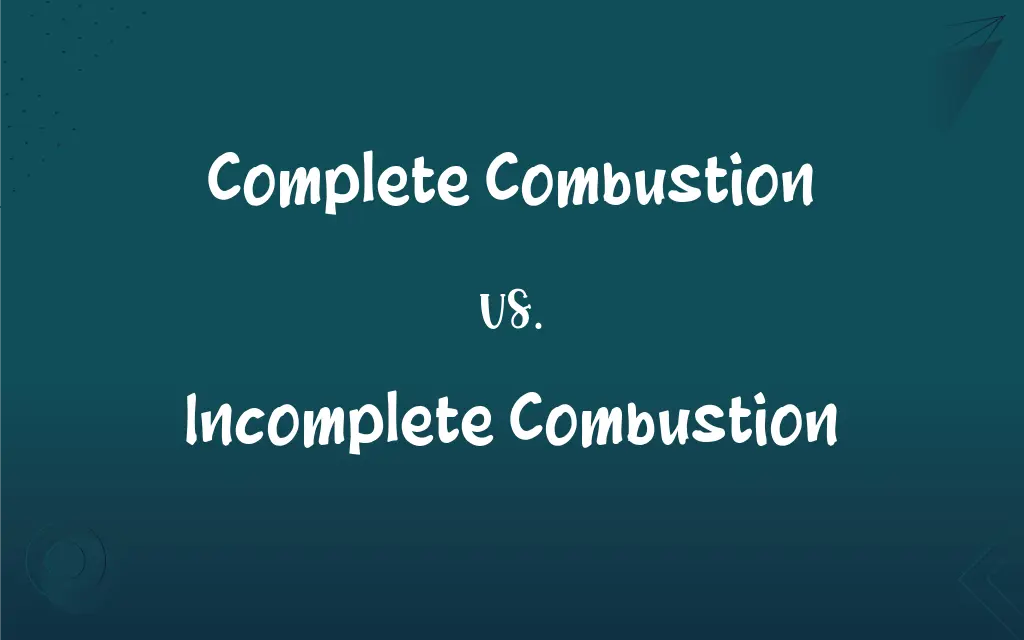Complete Combustion vs. Incomplete Combustion: What's the Difference?
Edited by Janet White || By Harlon Moss || Updated on October 24, 2023
Complete combustion occurs with ample oxygen, producing mainly carbon dioxide and water; incomplete combustion happens with limited oxygen, leading to carbon monoxide, water, and carbon.

Key Differences
Complete combustion is a reaction that burns a fuel source completely with a sufficient amount of oxygen. This means that the only byproducts of this combustion are typically carbon dioxide (CO2) and water (H2O). Incomplete combustion, on the other hand, happens when there isn't enough oxygen to allow the fuel to react completely. As a result, other byproducts such as carbon monoxide (CO) or even soot and particulates can form.
In an ideal scenario, complete combustion would always be preferred due to its efficiency and the lack of harmful byproducts. The fuel is entirely converted into energy, and there are no residues left that can harm the environment or human health. In contrast, incomplete combustion not only wastes part of the fuel but also produces harmful byproducts. Carbon monoxide, for instance, is a poisonous gas which, when inhaled, deprives the body's cells and tissues of oxygen.
The environments in which these combustions occur can influence their completeness. For example, a well-ventilated furnace or engine is more likely to achieve complete combustion. On the other hand, if the ventilation is poor or the fuel supply exceeds the available oxygen, incomplete combustion is more likely to occur.
It's essential to understand the distinction between complete combustion and incomplete combustion from both an efficiency and a safety perspective. For engines, heaters, or any combustion process, ensuring complete combustion means more efficient fuel use and reduced harmful emissions. Conversely, incomplete combustion can lead to performance issues and potential health risks due to the release of carbon monoxide.
Comparison Chart
Oxygen Availability
Ample oxygen available.
Limited oxygen supply.
ADVERTISEMENT
Main Byproducts
Carbon dioxide (CO2) and water (H2O).
Carbon monoxide (CO), water (H2O), and carbon.
Efficiency
Fuel is entirely converted into energy.
Part of the fuel remains unburned.
Environmental/Health Impact
Less harmful as mainly produces CO2 and H2O.
Produces harmful byproducts like CO.
Typical Conditions
Well-ventilated areas or controlled environments.
Poor ventilation or excess fuel relative to oxygen.
Complete Combustion and Incomplete Combustion Definitions
Complete Combustion
A combustion process where fuel burns entirely with sufficient oxygen.
In a controlled laboratory setting, the scientist achieved complete combustion of the hydrocarbon.
ADVERTISEMENT
Incomplete Combustion
A combustion process where fuel doesn't burn entirely due to insufficient oxygen.
The smoky flame indicated incomplete combustion in the lamp.
Complete Combustion
A reaction resulting in only carbon dioxide and water as byproducts.
The new engine design aims for complete combustion to reduce emissions.
Incomplete Combustion
The partial oxidation of fuel because of limited oxygen.
In the enclosed space, the fire displayed signs of incomplete combustion.
Complete Combustion
A burning process that utilizes all the fuel with minimal residues.
The blue flame indicates complete combustion in the burner.
Incomplete Combustion
A reaction that produces carbon monoxide, water, and sometimes soot.
The car's malfunctioning engine led to incomplete combustion and increased emissions.
Complete Combustion
An efficient combustion where fuel is fully converted to energy.
Complete combustion in the fireplace ensures maximum heat output with no soot.
Incomplete Combustion
A burning process that leaves residues due to suboptimal conditions.
The candle's flickering, yellow flame was a result of incomplete combustion.
Complete Combustion
The full oxidation of fuel due to ample oxygen availability.
With the improved air intake, the furnace now reaches complete combustion.
Incomplete Combustion
An inefficient combustion process where not all fuel is utilized.
The choked chimney caused incomplete combustion in the wood stove.
FAQs
Can incomplete combustion be dangerous?
Yes, it produces carbon monoxide, a poisonous gas harmful to health.
What results from incomplete combustion?
Incomplete combustion produces carbon monoxide, water, and sometimes carbon or soot.
Why is carbon monoxide from incomplete combustion harmful?
Carbon monoxide binds with hemoglobin, reducing oxygen delivery to body tissues.
What color flame indicates incomplete combustion?
A yellow, smoky flame often indicates incomplete combustion.
How can I achieve complete combustion in my fireplace?
Ensure good ventilation and use dry, well-seasoned wood.
How does incomplete combustion affect engine performance?
It can reduce efficiency, increase emissions, and potentially harm the engine.
Can complete combustion produce pollutants?
While it mainly produces CO2 and H2O, CO2 is a greenhouse gas contributing to global warming.
How do I recognize incomplete combustion in engines?
Excess emissions, reduced performance, or a smoky exhaust can indicate incomplete combustion.
Is carbon dioxide from complete combustion harmful?
While not directly poisonous like CO, CO2 is a major greenhouse gas contributing to climate change.
Does a blue flame always indicate complete combustion?
Generally, a blue flame suggests complete combustion, but other conditions should also be optimal.
Can incomplete combustion lead to fire hazards?
Yes, residues like soot can build up and pose a fire risk.
Can complete combustion occur in closed spaces?
It's challenging; without adequate oxygen, combustion tends to be incomplete.
What is complete combustion?
Complete combustion occurs when fuel burns entirely with sufficient oxygen, producing mainly carbon dioxide and water.
Why is complete combustion preferred?
Complete combustion is efficient, utilizing all fuel and producing fewer harmful byproducts.
What causes incomplete combustion?
Limited oxygen supply or poor ventilation often results in incomplete combustion.
Is complete combustion always achievable?
In ideal conditions, yes, but real-world factors like ventilation can affect it.
Why is my stove producing soot?
Soot is often a byproduct of incomplete combustion.
What role does ventilation play in combustion?
Proper ventilation ensures a sufficient oxygen supply, favoring complete combustion.
Are there devices to detect incomplete combustion?
Yes, carbon monoxide detectors can alert to high CO levels, indicating possible incomplete combustion.
Which is more energy-efficient, complete or incomplete combustion?
Complete combustion is more energy-efficient as it fully utilizes the fuel.
About Author
Written by
Harlon MossHarlon is a seasoned quality moderator and accomplished content writer for Difference Wiki. An alumnus of the prestigious University of California, he earned his degree in Computer Science. Leveraging his academic background, Harlon brings a meticulous and informed perspective to his work, ensuring content accuracy and excellence.
Edited by
Janet WhiteJanet White has been an esteemed writer and blogger for Difference Wiki. Holding a Master's degree in Science and Medical Journalism from the prestigious Boston University, she has consistently demonstrated her expertise and passion for her field. When she's not immersed in her work, Janet relishes her time exercising, delving into a good book, and cherishing moments with friends and family.
































































